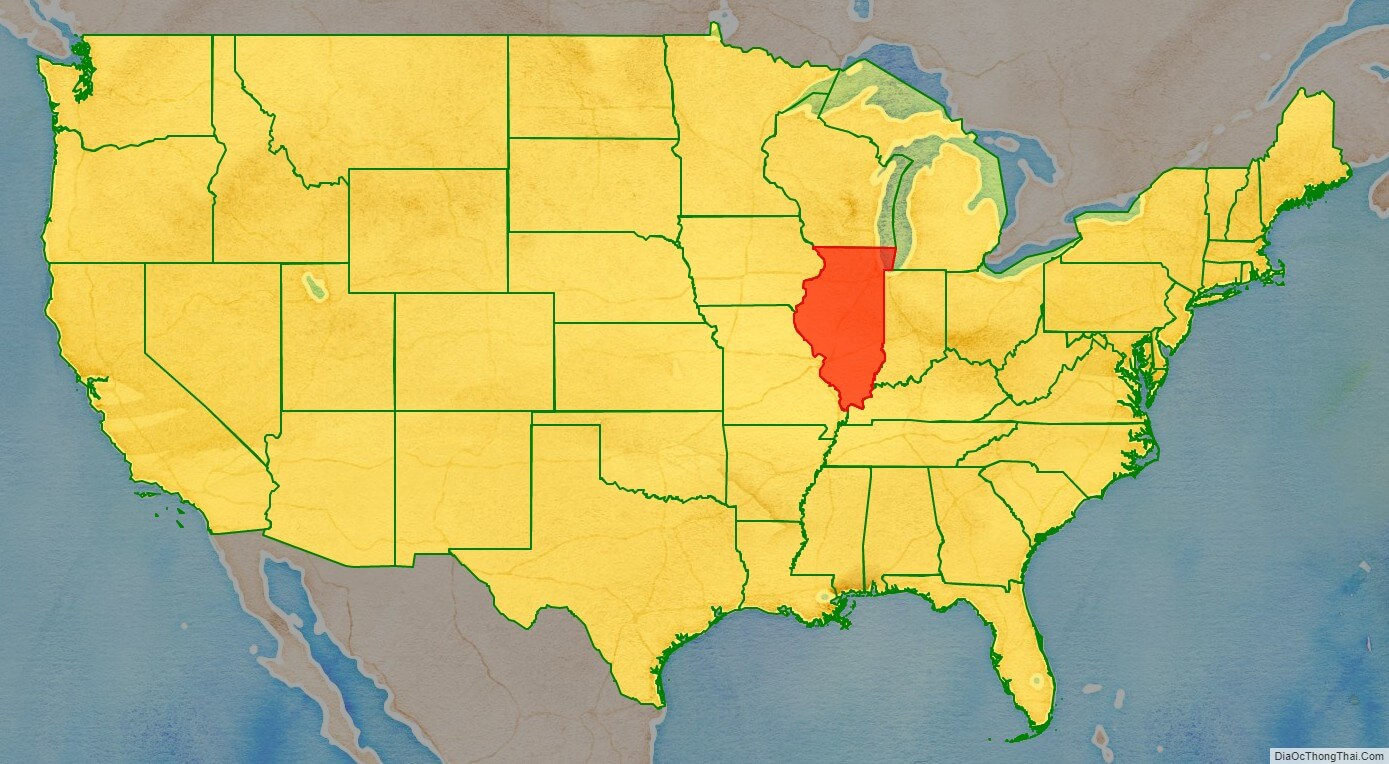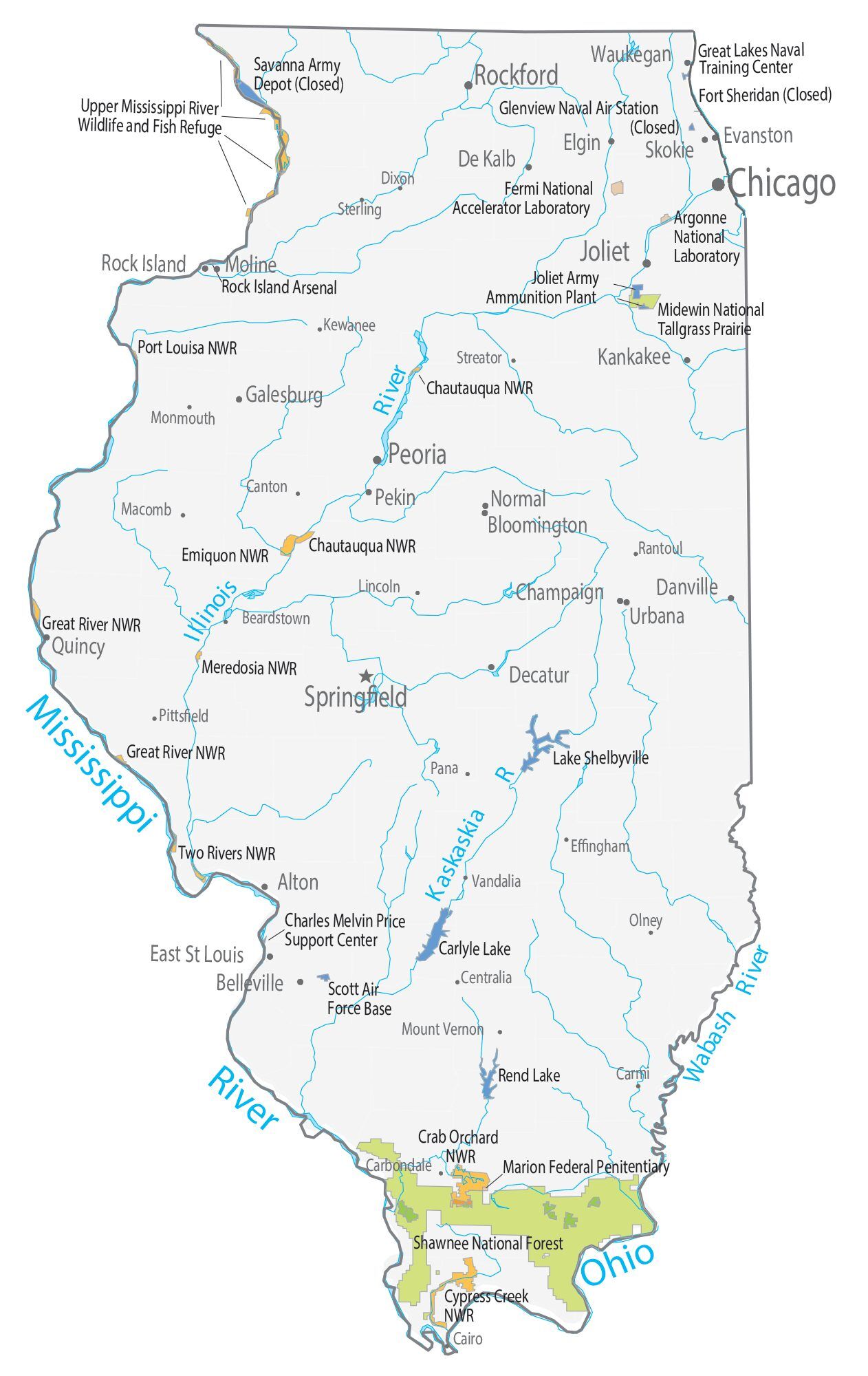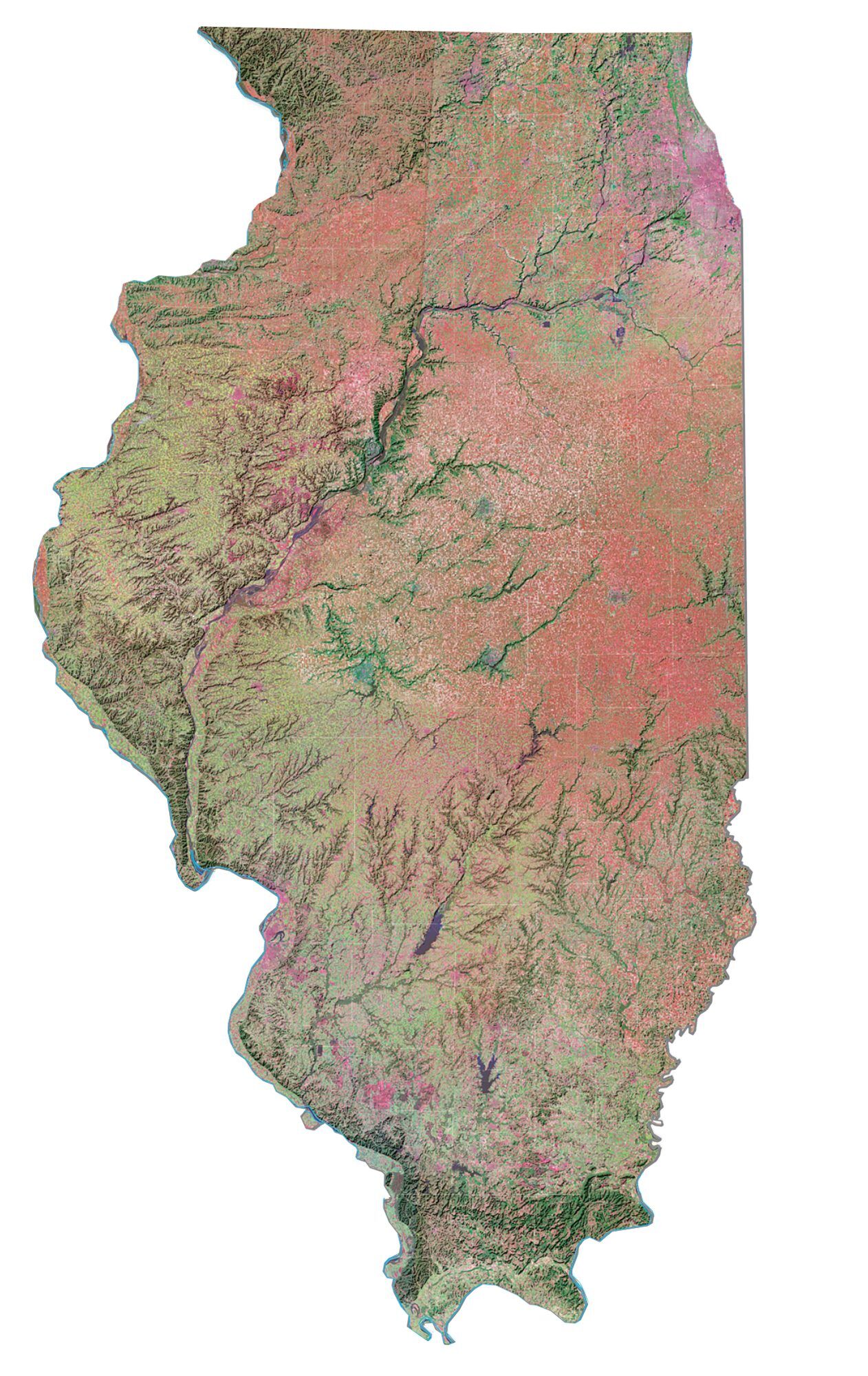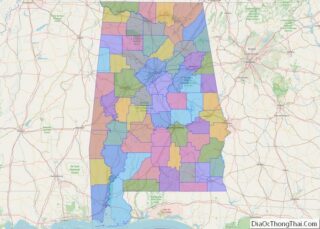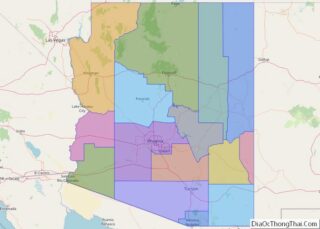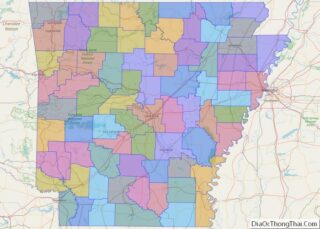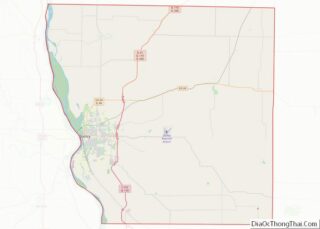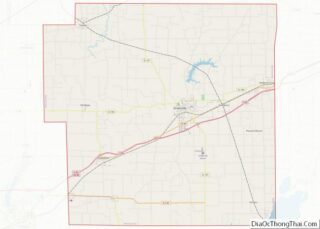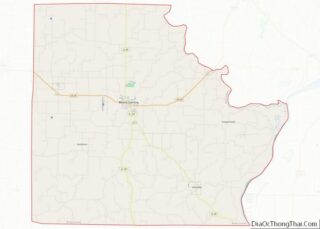Illinois (/ˌɪlɪˈnɔɪ/ (listen) IL-ə-NOY) is a state in the Midwestern United States. It shares borders with Wisconsin to its north, Iowa to its northwest, Missouri to its southwest, Kentucky to its south, and Indiana to its east. Its largest metropolitan areas include the Chicago metropolitan area, and the Metro East section, of Greater St. Louis. Other metropolitan areas include Peoria and Rockford, as well as Springfield, its capital. Of the fifty U.S. states, Illinois has the fifth-largest gross domestic product (GDP), the sixth-largest population, and the 25th-largest land area.
Illinois has a highly diverse economy, with the global city of Chicago in the northeast, major industrial and agricultural hubs in the north and center, and natural resources such as coal, timber, and petroleum in the south. Owing to its central location and favorable geography, the state is a major transportation hub: the Port of Chicago has access to the Atlantic Ocean through the Great Lakes and Saint Lawrence Seaway and to the Gulf of Mexico from the Mississippi River via the Illinois Waterway. Additionally, the Mississippi, Ohio, and Wabash rivers form parts of the state’s boundaries. Chicago’s O’Hare International Airport has been among the world’s ten busiest airports for decades. Illinois has long been considered a microcosm of the United States and a bellwether in American culture, exemplified by the phrase Will it play in Peoria?.
What is now Illinois was inhabited for thousands of years by various indigenous cultures, including the advanced civilization centered in the Cahokia region. The French were the first Europeans to arrive, settling near the Mississippi River in the 17th century, in the region they called Illinois Country, as part of the sprawling colony of New France. Following U.S. independence in 1783, American settlers began arriving from Kentucky via the Ohio River, and the population grew from south to north. Illinois was part of the United States’ oldest territory, the Northwest Territory, and in 1818 it achieved statehood. The Erie Canal brought increased commercial activity in the Great Lakes, and the small settlement of Chicago became one of the fastest growing cities in the world, benefiting from its location as one of the few natural harbors in southwestern Lake Michigan. The invention of the self-scouring steel plow by Illinoisan John Deere turned the state’s rich prairie into some of the world’s most productive and valuable farmland, attracting immigrant farmers from Germany and Sweden. In the mid-19th century, the Illinois and Michigan Canal and a sprawling railroad network greatly facilitated trade, commerce, and settlement, making the state a transportation hub for the nation.
By 1900, the growth of industrial jobs in the northern cities, and coal mining in the central and southern areas, attracted immigrants from Eastern and Southern Europe. Illinois became one of America’s most industrialized states and remains a major manufacturing center. The Great Migration from the South established a large community of African Americans, particularly in Chicago, who founded the city’s famous jazz and blues cultures. Chicago became a leading cultural, economic, and population center and is today one of the world’s major commercial centers; its metropolitan area, informally referred to as Chicagoland, holds about 65% of the state’s 12.8 million residents.
Three U.S. presidents have been elected while living in Illinois: Abraham Lincoln, Ulysses S. Grant, and Barack Obama; additionally, Ronald Reagan was born and raised in the state. Today, Illinois honors Lincoln with its official state slogan Land of Lincoln, which has been displayed on its license plates since 1954. The state is the site of the Abraham Lincoln Presidential Library and Museum in Springfield and the future home of the Barack Obama Presidential Center in Chicago.
| Before statehood: | Illinois Territory |
|---|---|
| Admitted to the Union: | December 3, 1818 (21st) |
| Capital: | Springfield |
| Largest city: | Chicago |
| Largest metro and urban areas: | Chicagoland |
| Elevation: | 600 ft (180 m) |
| Total Area: | 57,915 sq mi (149,997 km) |
| Area Rank: | 25th |
| Total Population: | 12,812,508 |
| Population Rank: | 6th |
| Population Density: | 232/sq mi (89.4/km) |
| Population Density Rank: | 12th |
| Median Household Income: | $65,030 |
| Income Rank: | 17th |
| Demonym(s): | Illinoisan |
| USPS abbreviation: | IL |
| ISO 3166 code: | US-IL |
| Website: | www.illinois.gov |
Online Interactive Map
Click on ![]() to view map in "full screen" mode.
to view map in "full screen" mode.
Illinois location map. Where is Illinois state?
Illinois Road Map
Illinois Map – Roads & Cities
Illinois Street Map
Illinois State Map – Places and Landmarks
Illinois Political Map
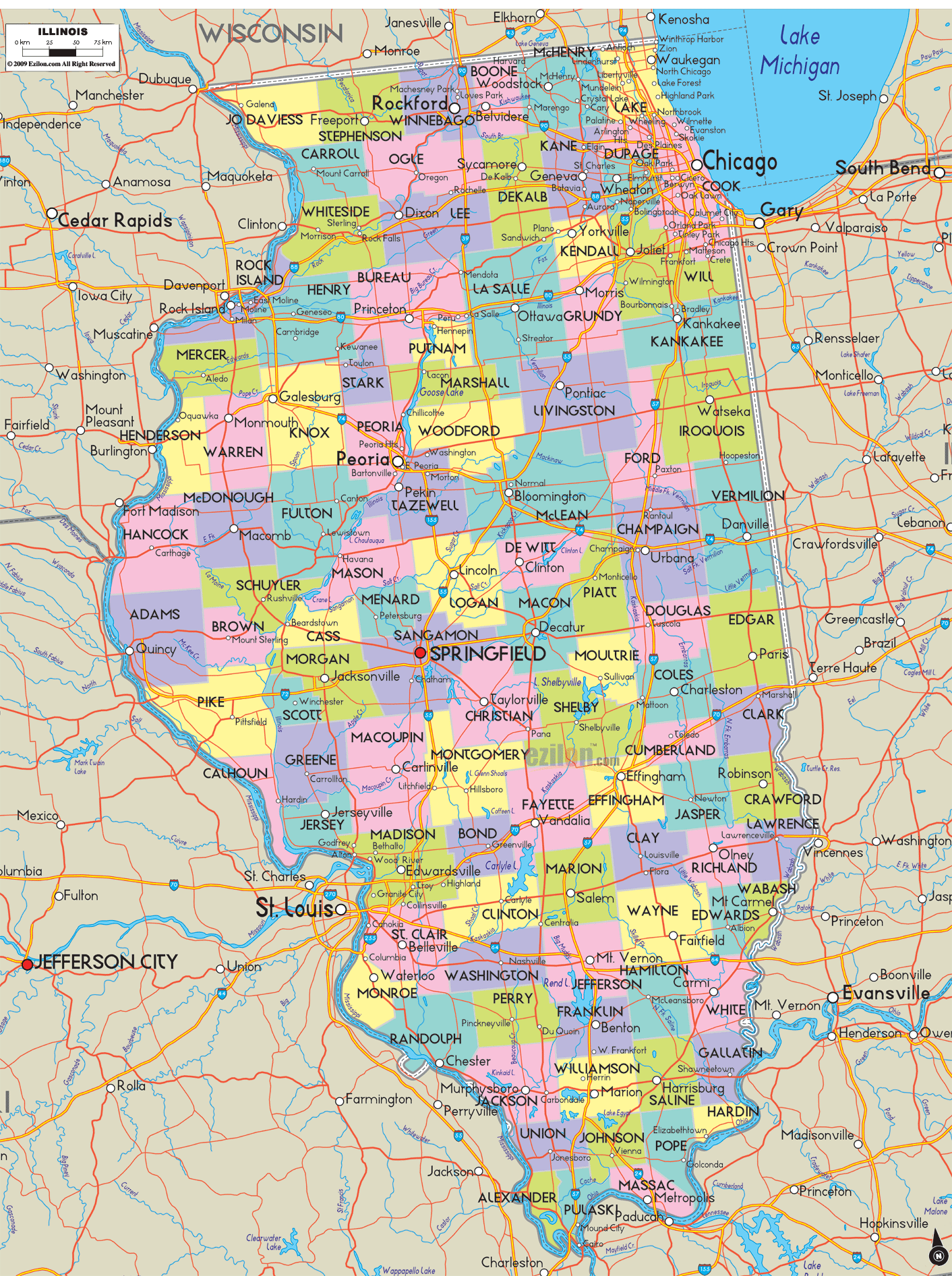
Illinois Lakes and Rivers Map
Geography
Illinois is located in the Midwest region of the United States and is one of the eight states in the Great Lakes region of North America (which also includes Ontario, Canada).
Boundaries
Illinois’s eastern border with Indiana consists of a north–south line at 87° 31′ 30″ west longitude in Lake Michigan at the north, to the Wabash River in the south above Post Vincennes. The Wabash River continues as the eastern/southeastern border with Indiana until the Wabash enters the Ohio River. This marks the beginning of Illinois’s southern border with Kentucky, which runs along the northern shoreline of the Ohio River. Most of the western border with Missouri and Iowa is the Mississippi River; Kaskaskia is an exclave of Illinois, lying west of the Mississippi and reachable only from Missouri. The state’s northern border with Wisconsin is fixed at 42° 30′ north latitude. The northeastern border of Illinois lies in Lake Michigan, within which Illinois shares a water boundary with the state of Michigan, as well as Wisconsin and Indiana.
Topography
Though Illinois lies entirely in the Interior Plains, it does have some minor variation in its elevation. In extreme northwestern Illinois, the Driftless Area, a region of unglaciated and therefore higher and more rugged topography, occupies a small part of the state. Southern Illinois includes the hilly areas around the Shawnee National Forest.
Charles Mound, located in the Driftless region, has the state’s highest natural elevation above sea level at 1,235 ft (376 m). Other highlands include the Shawnee Hills in the south, and there is varying topography along its rivers; the Illinois River bisects the state northeast to southwest. The floodplain on the Mississippi River from Alton to the Kaskaskia River is known as the American Bottom.
Divisions
Illinois has three major geographical divisions. Northern Illinois is dominated by Chicago metropolitan area, or Chicagoland, which is the city of Chicago and its suburbs, and the adjoining exurban area into which the metropolis is expanding. As defined by the federal government, the Chicago metro area includes several counties in Illinois, Indiana, and Wisconsin, and has a population of over 9.8 million. Chicago itself is a cosmopolitan city, densely populated, industrialized, the transportation hub of the nation, and settled by a wide variety of ethnic groups. The city of Rockford, Illinois’s third-largest city and center of the state’s fourth largest metropolitan area, sits along Interstates 39 and 90 some 75 mi (121 km) northwest of Chicago. The Quad Cities region, located along the Mississippi River in northern Illinois, had a population of 381,342 in 2011.
The midsection of Illinois is the second major division, called Central Illinois. Historically prairie, it is now mainly agricultural and known as the Heart of Illinois. It is characterized by small towns and medium–small cities. The western section (west of the Illinois River) was originally part of the Military Tract of 1812 and forms the conspicuous western bulge of the state. Agriculture, particularly corn and soybeans, as well as educational institutions and manufacturing centers, figure prominently in Central Illinois. Cities include Peoria; Springfield, the state capital; Quincy; Decatur; Bloomington-Normal; and Champaign–Urbana.
The third division is Southern Illinois, comprising the area south of U.S. Route 50, including Little Egypt, near the juncture of the Mississippi River and Ohio River. Southern Illinois is the site of the ancient city of Cahokia, as well as the site of the first state capital at Kaskaskia, which today is separated from the rest of the state by the Mississippi River. This region has a somewhat warmer winter climate, different variety of crops (including some cotton farming in the past), more rugged topography (due to the area remaining unglaciated during the Illinoian Stage, unlike most of the rest of the state), as well as small-scale oil deposits and coal mining. The Illinois suburbs of St. Louis, such as East St. Louis, are located in this region, and collectively, they are known as the Metro-East. The other somewhat significant concentration of population in Southern Illinois is the Carbondale-Marion-Herrin, Illinois Combined Statistical Area centered on Carbondale and Marion, a two-county area that is home to 123,272 residents. A portion of southeastern Illinois is part of the extended Evansville, Indiana, Metro Area, locally referred to as the Tri-State with Indiana and Kentucky. Seven Illinois counties are in the area.
In addition to these three, largely latitudinally defined divisions, all of the region outside the Chicago metropolitan area is often called “downstate” Illinois. This term is flexible, but is generally meant to mean everything outside the influence of the Chicago area. Thus, some cities in Northern Illinois, such as DeKalb, which is west of Chicago, and Rockford—which is actually north of Chicago—are sometimes incorrectly considered to be ‘downstate’.
Climate
Illinois has a climate that varies widely throughout the year. Because of its nearly 400-mile distance between its northernmost and southernmost extremes, as well as its mid-continental situation, most of Illinois has a humid continental climate (Köppen climate classification Dfa), with hot, humid summers and cold winters. The southern part of the state, from about Carbondale southward, has a humid subtropical climate (Koppen Cfa), with more moderate winters. Average yearly precipitation for Illinois varies from just over 48 in (1,219 mm) at the southern tip to around 35 in (889 mm) in the northern portion of the state. Normal annual snowfall exceeds 38 in (965 mm) in the Chicago area, while the southern portion of the state normally receives less than 14 in (356 mm). The all-time high temperature was 117 °F (47 °C), recorded on July 14, 1954, at East St. Louis, and the all-time low temperature was −38 °F (−39 °C), recorded on January 31, 2019, during the January 2019 North American cold wave at a weather station near Mount Carroll, and confirmed on March 5, 2019. This followed the previous record of −36 °F (−38 °C) recorded on January 5, 1999, near Congerville. Prior to the Mount Carroll record, a temperature of −37 °F (−38 °C) was recorded on January 15, 2009, at Rochelle, but at a weather station not subjected to the same quality control as official records.
Illinois averages approximately 51 days of thunderstorm activity a year, which ranks somewhat above average in the number of thunderstorm days for the United States. Illinois is vulnerable to tornadoes, with an average of 35 occurring annually, which puts much of the state at around five tornadoes per 10,000 sq mi (30,000 km) annually. While tornadoes are no more powerful in Illinois than other states, some of Tornado Alley’s deadliest tornadoes on record have occurred in the state. The Tri-State Tornado of 1925 killed 695 people in three states; 613 of the victims died in Illinois.
Urban areas
Chicago is the largest city in the state and the third-most populous city in the United States, with its 2020 population of 2,746,388. The U.S. Census Bureau currently lists seven other cities with populations of over 100,000 within Illinois. Based upon the U.S. Census Bureau’s official 2010 population: Aurora, a Chicago satellite town that eclipsed Rockford for the title of second-most populous city in Illinois; its 2010 population was 197,899. Rockford, at 152,871, is the third-largest city in the state, and is the largest city in the state not located within the Chicago suburbs. Joliet, located in metropolitan Chicago, is the fourth-largest city in the state, with a population of 147,433. Naperville, a suburb of Chicago, is fifth with 141,853. Naperville and Aurora share a boundary along Illinois Route 59. Springfield, the state’s capital, comes in as sixth-most populous with 117,352 residents. Peoria, which decades ago was the second-most populous city in the state, is seventh with 115,007. The eighth-largest and final city in the 100,000 club is Elgin, a northwest suburb of Chicago, with a 2010 population of 108,188.
The most populated city in the state south of Springfield is Belleville, with 44,478 people at the 2010 census. It is located in the Illinois portion of Greater St. Louis (often called the Metro-East area), which has a rapidly growing population of over 700,000.
Other major urban areas include the Champaign-Urbana Metropolitan Area, which has a combined population of almost 230,000 people, the Illinois portion of the Quad Cities area with about 215,000 people, and the Bloomington-Normal area with a combined population of over 165,000.
Illinois Physical Map
Illinois Topographic Map
Illinois Satellite Map
Others printable maps
Illinois Outline Map
Blank Illinois County Map
See also
Map of Illinois State and its subdivision:- Adams
- Alexander
- Bond
- Boone
- Brown
- Bureau
- Calhoun
- Carroll
- Cass
- Champaign
- Christian
- Clark
- Clay
- Clinton
- Coles
- Cook
- Crawford
- Cumberland
- De Kalb
- De Witt
- Douglas
- Dupage
- Edgar
- Edwards
- Effingham
- Fayette
- Ford
- Franklin
- Fulton
- Gallatin
- Greene
- Grundy
- Hamilton
- Hancock
- Hardin
- Henderson
- Henry
- Iroquois
- Jackson
- Jasper
- Jefferson
- Jersey
- Jo Daviess
- Johnson
- Kane
- Kankakee
- Kendall
- Knox
- La Salle
- Lake
- Lake Michigan
- Lawrence
- Lee
- Livingston
- Logan
- Macon
- Macoupin
- Madison
- Marion
- Marshall
- Mason
- Massac
- McDonough
- McHenry
- McLean
- Menard
- Mercer
- Monroe
- Montgomery
- Morgan
- Moultrie
- Ogle
- Peoria
- Perry
- Piatt
- Pike
- Pope
- Pulaski
- Putnam
- Randolph
- Richland
- Rock Island
- Saint Clair
- Saline
- Sangamon
- Schuyler
- Scott
- Shelby
- Stark
- Stephenson
- Tazewell
- Union
- Vermilion
- Wabash
- Warren
- Washington
- Wayne
- White
- Whiteside
- Will
- Williamson
- Winnebago
- Woodford
- Alabama
- Alaska
- Arizona
- Arkansas
- California
- Colorado
- Connecticut
- Delaware
- District of Columbia
- Florida
- Georgia
- Hawaii
- Idaho
- Illinois
- Indiana
- Iowa
- Kansas
- Kentucky
- Louisiana
- Maine
- Maryland
- Massachusetts
- Michigan
- Minnesota
- Mississippi
- Missouri
- Montana
- Nebraska
- Nevada
- New Hampshire
- New Jersey
- New Mexico
- New York
- North Carolina
- North Dakota
- Ohio
- Oklahoma
- Oregon
- Pennsylvania
- Rhode Island
- South Carolina
- South Dakota
- Tennessee
- Texas
- Utah
- Vermont
- Virginia
- Washington
- West Virginia
- Wisconsin
- Wyoming
